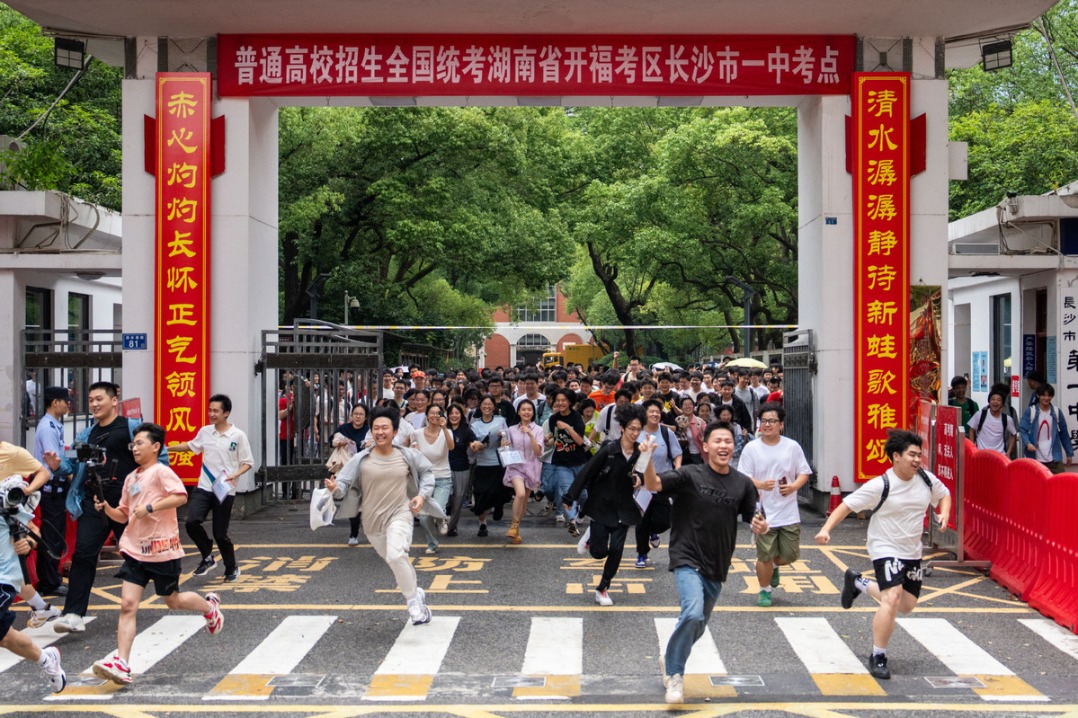Discovering gut drones, riding with senior bikers and becoming a bangbang

A 35-day, 2,000-kilometer journey to 11 cities along the Yangtze River Economic Belt showed how the area has been transformed by 40 years of reform and opening-up. Erik Nilsson reports.?
Editor's note: Discover China: Behind the Rapid Growth is a China Daily documentary series exploring how reform and opening-up has transformed the country over the past four decades. Three foreign journalists journeyed thousands of kilometers through three major economic zones to discover the secrets of human history's greatest economic miracle. They traveled to 28 cities in 90 days, jumping in the way of self-driving buses, breaking mobile phones, catching fish, driving drones, riding motorcycles, joining a distinctive group of porters, and so much more. This is the behind-the-scenes story.
I recently drove a gastrointestinal-camera drone the size and shape of a pill in Wuhan, capital of Hubei province.
Basically, it was a gut drone. I was disappointed that time constraints didn't allow me to swallow it and drive it around my digestive system, filming.
That would have truly been getting the story from the inside out. Instead, I used two joysticks to make it dance like a jumping bean on a table.
It was like an arcade game. However, it's actually one of the greatest advancements in lifesaving endoscopic technology in about two decades.
Three decades ago, Wuhan's Optics Valley, where I operated the device, was a vast wasteland. It has since been transformed into a massive high-tech zone that's a nationally leading base for fiber optics, biomedicine and web-celeb livestreaming.
I also joined an online celebrity to sing a livestreamed duet in the valley.
I visited Wuhan during a recent 2,000-kilometer journey to 11 cities as a documentarian and writer to explore how reform and opening-up has transformed the Yangtze River Economic Belt in the past four decades.
I'd expected lots of factories and ports. And I was right.
But I also discovered many unexpected dimensions of the development of the economic belt that accounts for about 40 percent of the country's population and GDP.
I tried a medical rehabilitation routine taught by a digital tai chi instructor, directed by the internet of things in Wuxi, Jiangsu province.
I joined a fishing crew in the city to haul up nets and sort catches. The family told me how Lake Taihu has recovered after an outbreak of blue-green algae a decade ago.
The pollution generated by unchecked development that left about 1 million people without drinking water guided the government to direct enterprises toward green and innovative sectors such as IoT.
I rode along with a club of biker grandpas and a few grannies in Chongqing.
The improved roads in the notoriously hilly city-where journeys from its center to its most-difficult-to-reach district used to take around 26 hours-mean the elderly motorcycle enthusiasts (the oldest is 87) can reach the municipality's border from downtown in four hours. The China Knights even ride their hogs to such destinations as Russia, Laos and Nepal.
I also joined the bangbang, who are vanishing as Chongqing's transportation sector improves. I was the youngest bangbang that day-and perhaps for decades-since young people aren't willing to do the hard work of these porters, who carry goods uphill on bamboo poles.
Indeed, I discovered that balancing loads dangling from both ends of the stick on my shoulders to be tricky-to the point that I seemed to dance down the street, initially swaying back and forth as much as heading forward, as if I were drunk.
I was almost run over by a robot in a car factory in Shanghai, where I also rode in an intelligent vehicle. Automation and artificial intelligence are advancing in an automobile industry that had to import nearly all of its parts decades ago.
Most of these unanticipated experiences are linked to innovation, especially technological, in the relatively underdeveloped cities in the central and western parts of China that I visited during my 35-day journey.
I used a phone app that relies on big data to water a field of kiwifruit in Shuicheng, Guizhou province.
Topographically treacherous, Guizhou is a telling specimen of the unexpected contours of the most-recent advances of reform and opening-up.
The province has long been one of the country's poorest because its karst landscape has obstructed development.
But Guizhou is transforming its geology from a disadvantage into an advantage by using innovation-namely, big data.
The area's undulating terrain is seismically stable. And its elevation means steady air temperatures year-round.
This makes it ideal for storing big data hardware, such as servers that are sensitive to earthquakes and changes in weather.
At one point, I wondered why we'd stopped in front of a forested mountainside along a road wriggling through Guizhou's wilderness.
Turns out, a big data center operates inside the mountain. The temperatures in caves are especially steady, and the province's dissolved-limestone landscapes are naturally pocked with these sorts of caverns.
Some data centers are located in man-made tunnels bored between two peaks. Guizhou's data economy grew by more than 37 percent last year, and its added value is expected to account for 30 percent of the province's GDP by 2020.
The Yangtze expedition offered a new perspective on many things I already knew but hadn't fully put together-like exactly how the cities in the economic belt complement one another through specialization and integration to maximize their geological conditions and geographical positions.
The journey offered unique perspectives on how coordinated development within the context of reform and opening-up has transformed the Yangtze-broadcast by a gut drone, seen from inside a self-driving car or viewed from the back of a retiree's motorcycle.
- Cultural creations made by Chinese women with disabilities showcased at UN headquarters
- China-Europe conference advances vocational education, AI talent
- China completes 75% of summer wheat harvest
- China and South Africa strengthen defense ties at 10th meeting
- China-ASEAN trade grows 9.1%, boosting Guangxi's role
- 5.8-magnitude quake hits waters off Taiwan: CENC





































